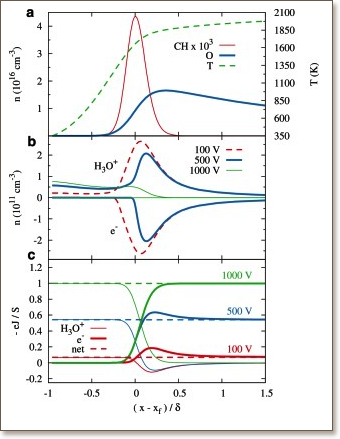

J. Han, M. Belhi, T. A. Casey, F. Bisetti, H. G. Im, J. Y. Chen
Proceedings of the Combustion Institute 36 (1), 241-1250, (2017)

The i−Vi−V curve describes the current drawn from a flame as a function of the voltage difference applied across the reaction zone. Since combustion diagnostics and flame control strategies based on electric fields depend on the amount of current drawn from flames, there is significant interest in modeling and understanding i−Vi−V curves. We implement and apply a detailed model for the simulation of the production and transport of ions and electrons in one-dimensional premixed flames. An analytical reduced model is developed based on the detailed one, and analytical expressions are used to gain insight into the characteristics of the i−Vi−V curve for various flame configurations. In order for the reduced model to capture the spatial distribution of the electric field accurately, the concept of a dead zone region, where voltage is constant, is introduced, and a suitable closure for the spatial extent of the dead zone is proposed and validated. The results from the reduced modeling framework are found to be in good agreement with those from the detailed simulations. The saturation voltage is found to depend significantly on the flame location relative to the electrodes, and on the sign of the voltage difference applied. Furthermore, at sub-saturation conditions, the current is shown to increase linearly or quadratically with the applied voltage, depending on the flame location. These limiting behaviors exhibited by the reduced model elucidate the features of i−Vi−V curves observed experimentally. The reduced model relies on the existence of a thin layer where charges are produced, corresponding to the reaction zone of a flame. Consequently, the analytical model we propose is not limited to the study of premixed flames, and may be applied easily to others configurations, e.g. nonpremixed counterflow flames.